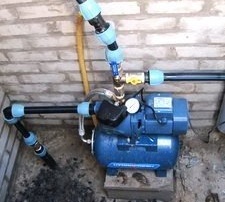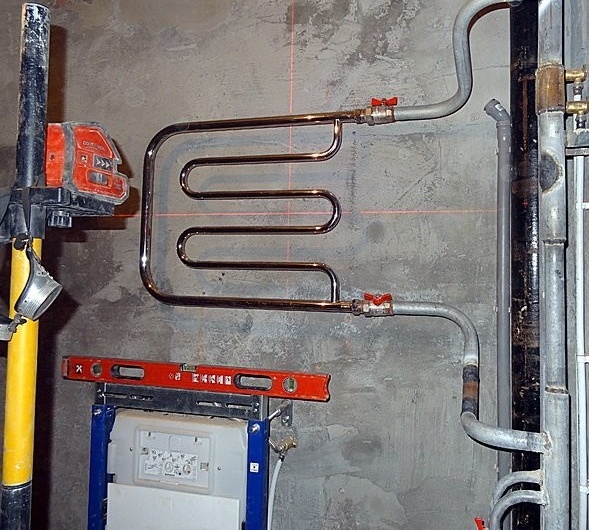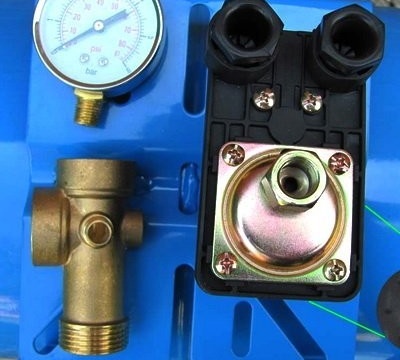Installation and connection of the pumping station to the well: algorithm of work
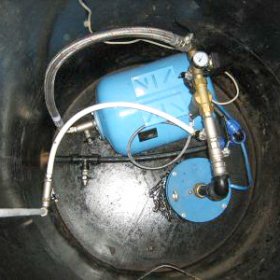
The lack of central water supply is now no longer an insurmountable barrier to providing water for private houses and summer cottages in the countryside. This issue can be easily solved with the help of a device on a personal plot of wells or wells of various depths, depending on the location of the aquifer. To create a pressure in the water supply network that is sufficient for connecting and constantly operating plumbing equipment, pumping stations for wells are used.
These compact units provide lifting water from a depth of up to 20 meters, and its even distribution under good pressure at all points of water consumption in the house. Thus, a person does not experience any discomfort due to lack of water or its absence, if there is no interruption in the supply of electricity. However, this problem can now be solved by using generators and mini-power plants.
Choosing the right pump station model
At choosing a pumping station are guided not only by the cost of equipment, but also by its operating mode, as well as other technical characteristics. We note right away that small-sized pumping stations are purchased only if the depth of the drilled well does not exceed 20 meters. In deeper wells, the use of this equipment is considered inefficient and unprofitable.
When choosing a pumping station model, remember the following tips.
- For wells with a depth of less than 10 m, single-tube stations are acquired. Their installation is very simple.
- For deeper wells (10-20 m), only ejector two-pipe stations are suitable, the power and design of which will ensure the rise and distribution of water.
- If you plan to install a pumping station in the basement of a house, then you need to pay attention to less noisy models. As a rule, in low-noise units, the manufacturer installs plastic impellers. You should not save on the cost of products, since the noise from the operation of cheap and little-known equipment will cause many inconveniences during operation.
If the depth of the drilled well exceeds 20 meters, then the installation of the pumping station in the well is not performed. In this case, acquire a special submersible pumpwhich delivers water to an intermediate tank equipped with sensors that monitor the upper and lower liquid levels. When analyzing water, the automatics turns on the pump. Water from the tank enters the water supply network through a hydrophore - a device capable of maintaining a given level of pressure in the pipeline.
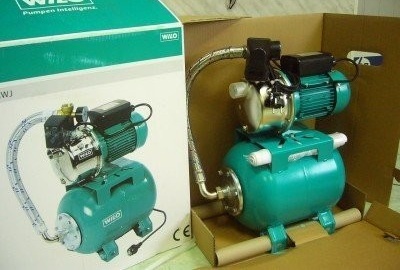
The Wilo-Jet HWJ water supply pump station, the housing, the impeller and shaft of which is made of stainless steel, provides a 8 m water column
Our next material presents expert recommendations on the choice of pumping stations, and also lists a number of equipment manufacturers who have established themselves on the market:https://aquatech.tomathouse.com/en/voprosy/16738.html.
The principle of operation of single-tube and double-tube stations
Depending on the type of suction pipe device, all pumping stations can be divided into two groups:
- single tube;
- two-pipe (ejector).
For single-tube stations, the design of the water intake is quite simple, since water flows along the same line into the pump casing. In two-pipe stations, the design device is much more complicated. But this equipment, having less power, is able to provide a rise in water from a greater depth. This is achieved due to the fact that the water rises due to the vacuum created by the impeller of the pump, which increases due to the inertia of the water, which circulates in a circle during operation of the station.
Choosing a pumping station location
If possible, it is better to connect the pumping station to the well not in the basement of the house, but in a separately constructed room on a site located farther from the house. This will save people living at the facility from the noise that occurs when the equipment is running. The room should be dry, since only in this case is it possible to operate properly and safely in pumping equipment that is dependent on electricity.
In the technical room, the station is installed on a solid concrete floor or on a pedestal made of bricks or knocked down from wooden blocks. Before installing the unit, it is advisable to place a rubber mat under it, which partially absorbs vibration. The pumping station is attached to the base with anchors, which are driven into the holes provided in the legs of the unit.
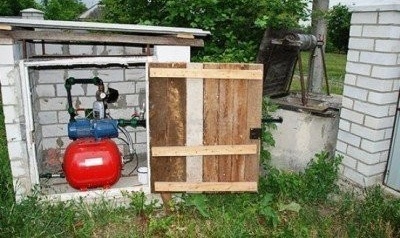
The installation of a pumping station that emits noise during operation is best done in a separate room, equipped on a personal plot near the well
If the water supply to the house is not from a well, but from a well, then the following material about connecting equipment can be useful to you:https://aquatech.tomathouse.com/en/vodosnab/kolod-skvaj/podklyuchenie-nasosnoj-stancii-k-kolodcu.html.
Self-assembly and connection
Two exits available at the pumping station are designed for its connection to the well and to the water supply system of the house. First, they begin to connect the unit to the well. For this, a polyethylene pipe is taken, the diameter of which should be equal to 32 mm. The pipe, of course, must be integral, which eliminates the possibility of leaks. Therefore, it is better to buy a pipe with a small margin, if anything, the excess can be cut off. One end of the pipe is lowered into the well, and the other is connected to a pump mounted directly in the station. If necessary, the polyethylene pipe is insulated using materials manufactured by Termoflex as a heater.
At the end of the pipe, lowered into the well, a metal mesh is attached, which serves as a coarse filter. There they fix the check valve necessary to ensure that the pipe is constantly filled with water. Only in this case will the pump be able to pump water from the well. An external thread coupling is used to secure the check valve and filter.
The second end of the polyethylene pipe is attached to the pump using the same coupling. First, an American crane is connected to the outlet of the station, then to it is a sleeve with an external thread, and then a polyethylene pipe with collet connection.
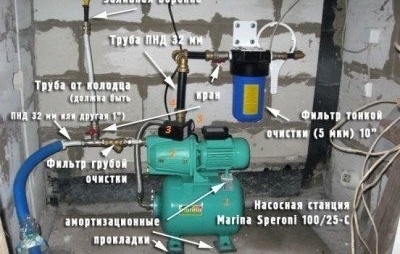
Connection diagram of a compact pumping station to a well and a pipeline of a water supply system of a private house, indicating the most important connections
A pump station is connected to the pipeline using a second outlet, which is usually located at the top of the unit. In this case, the American crane is also connected to the station by a threaded connection.Then a polypropylene combined sleeve is screwed into the tap, the diameter of which is 32 mm, and the angle is 90 degrees, the length of the external thread is 1 inch. A durable connection of a polypropylene water pipe with a coupling is ensured by soldering these elements.
You may find this material useful with instructions for troubleshooting the most common problems:https://aquatech.tomathouse.com/en/vodosnab/nasos/nasos-stancii/remont-nasosnoj-stancii-svoimi-rukami.html.
As you can see, installation and connection of the pumping station to the well can be carried out independently. If you do not want to delve into the intricacies of installation work, then hire specialists.
